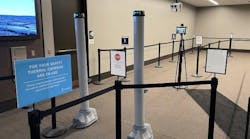Washington, Nov. 25 -- Researchers at Sandia National Laboratories in California are developing a neutron scatter camera, which they say may solve the problem of identifying smuggled nuclear material.
The researchers say that the new camera will have the ability to detect radiation from much greater distances, and through more shielding than current detection instruments.
Sandia physicist Nick Mascarenhas says that the neutron scatter camera will help detect the presence of radiation, its source, and the amount of its emanation.
The camera's ability to count neutrons from a source of special nuclear material (SNM) will allow this detection process.
"This instrument can pinpoint a hot spot in another room through walls, something not typically possible with gamma-ray detectors. Performance-wise, it's beating the older technologies, but we want to continue to push the limits of sensitivity and detection distance," says Mascarenhas.
He says that distance is a significant benchmark because it means the neutron scatter camera has the potential to detect through various types of shielding, a concern at any border crossing or point of entry.
So far, the results of neutron scatter camera testing have been encouraging.
"It's more penetrating and can detect unambiguously at a greater distance and through more shielding," says Jim Lund, who manages the Rad/Nuc Detection Systems group at Sandia/California.
After successful initial development, the camera is being transitioned to both the Defense Threat Reduction Agency (DTRA) and Domestic Nuclear Detection Office (DNDO) to support specific application studies.
Representatives from the DNDO sat in on a presentation by Mascarenhas to the National Nuclear Security Administration (NNSA) recently.
They were highly impressed to inquire how quickly the camera could be modified for shipping to and from Hawaii as part of Sandia's in-transit radiation characterization project, which has been examining the viability of radiation detection onboard a ship.
"There are neutrons all over the place from cosmic radiation, even when you are sitting indoors," says Mascarenhas.
"Our instrument can measure the energies, rates and angular variation. This is important in understanding standard operating conditions. You can't really detect anomalies until you understand what's normal. This data can also be used to improve instruments to better suppress the standard operation conditions," he adds.
Sandia physicist George Lasche, who leads the project known as Experimental Limits for In-Transit Detection of Radiological Materials, says the camera has the potential to reduce false alarm rates, a critical issue for in-transit radiation detection.
"Our other instruments have told us a lot about the nature of nuclear radiation at sea, but not where it is coming from," says Lasche.
"The neutron scatter camera can tell us where the radiation is coming from and whether it is coming from a small object or not. This information is very helpful in deciding if we have a serious threat on our hands, and can lead to fewer false alarms and a better chance of not missing the real thing," he says.
The neutron scatter camera has an advantage over traditional neutron detection as it can differentiate low energy neutrons from high-energy neutrons.
"It doesn't have to worry about the low-energy nuisance neutrons that are always all around us because it can only see high energy neutrons, and the high-energy neutrons carry almost all of the imaging information," says Lasche.
Jim Lund, however, concedes that the neutron scatter camera has certain limitations, particular in terms of size and time.
He says: "Ideally, we'd use both the neutron scatter camera and a gamma-ray detector. The neutron scatter camera is not practical as a handheld detector with immediate feedback."
But Mascarenhas still insists that the new technology is very effective.
He says: "We are not concerned with size at this point - our mission is to understand everything about the performance of this instrument and make it the best it can be. Making it portable or compact might be the next steps, but that's something I'm confident that Sandia, as an engineering laboratory, can solve."
Published by HT Syndication with permission from Asian News International.


